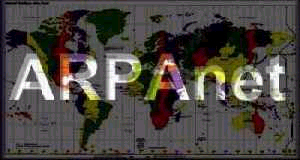
copyrighted. Mary Bellis
- Durin the Cold War in 1969, work began on the ARPAnet, grandfather to the Internet. Designed as a computer version o fthe nuclear bomb shelter, ARPAnet protected the flow of information between military bases by creating a betwork of geographically seperated computers that could exchange information via a newly developed protocol call NCP, Network Control Protocol.
- An opposing view to the ARPAnet's origin comes from Charles M. Herzfeld, the former directot of ARPA. HE claimed that ARPAnet was not created as a result of a military need, but rather as the result of a limited number of large, powerful research computers in the country and that many research investigators, who should have access, were geographically seperated from them. ARPA stands for the Advanced Research Projects Agency, a branch of the military that developed top secret systems and weapons druing the Cold War.
- The first data to be exchange on the ARPAnet occurred between UCLA's and Stanford's computers. On the first attempt to log into Stanford's computer by typing "log win", UCLA researchers had their computer crash when the typed the letter "g".
- Four DEC PDP1- computers were the first connected in the original ARPAnet, and each was located in the respective computer labs of UCLA, Stanford, UC Santa Barbara, and the University of Utah. As the network expanded, different models of computers were connected to ARPAnet, different models of computers were connected to ARPAnet, creating compatibility problems. The problem was solved by a better protocol call TCP/IP (Transmission Control Protocol/Internet Protocol) being designed in 1982. To send a message on the network, a computer breaks its data into IP (Internet Protocol) packets, like delivering digital envelopes with an "address" to go to. TCP (Transmission Control Protocol) made sure the packets were delivered from client to server and recieved on the right order.
- Using ARPAnet, serveral major innovations occured:
a) Email- the ability to send simple messages to another person across the net (1971)
b) Telnet- a remote connection service for controlling a computer (1972)
c) File Transfer (FTP)- allowed information to be sent from one place to another in bulk (1973)
- As non-military uses for the network increased, so many people had access to the network, and it was no longer safe for militaru purposes. As a result, MILnet, a military only network was started in 1983. IP software was soon being placed on every type of computer and universities and research groups also began using in-house networks known as Local Area Networks ot LAN's. Theses in-house networks then started using IP software so a LAN could connect with other LAN's.
- In 1986, on LAN branched out to form a new competing network, called NSFnet (National Science Foundation Network). NSFnet first linked together the five national super computer centers, but then every major university joined NSFnet, and it started to replace the slower ARPAnet, which was finally shutdown in 1990. NSFnet formed the backbone of what we call the Internet today.